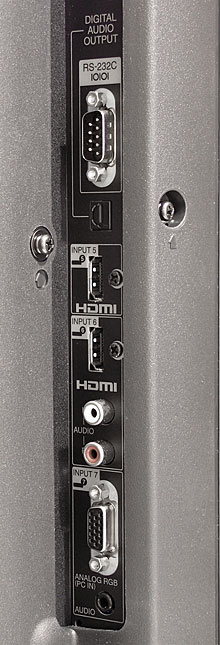Sharp AQUOS LC-52D64U 52" LCD HDTV Page 2
 The fly in the soup was the Sharp's performance in the dark grays and blacks. It's vastly improved over what was considered state-of-the-art in LCD displays even just two years ago. Set the brightness control correctly and you may never see anything amiss.
The fly in the soup was the Sharp's performance in the dark grays and blacks. It's vastly improved over what was considered state-of-the-art in LCD displays even just two years ago. Set the brightness control correctly and you may never see anything amiss.
But I found that when I set Brightness to the technically correct level using test patterns, bright scenes often had a slightly faded, two-dimensional appearance. A step or two darker crushed the blacks a bit, somewhat compromising shadow detail that was not that special to start with. But this often reduced that pale look.
Active Contrast control did improve the image on some material, and it produced better test bench results (see "Measurements.") But it could also degrade the picture, depending on the programming. The positive benefits, when they occurred, included better image punch and enhanced depth. The negatives, which were just as likely to appear as not, were a slightly garish look and, in a least one scene I viewed, a pasty look, particularly on flesh tones.
The Fine Motion control (On or Off also) did help with motion on some sorts of material, but it could also, unexpectedly, darken the image. This would sometimes be an improvement, either alone or together with Active Contrast. At other times using only one of the two controls (or neither) would be best.
As you can see, getting the best results in the departments of shadow detail, blacks, image "pop," and contrast depended on a bit of juggling with three different controls—and the best setting varied with the program material. Most of the time I preferred leaving both Active Contrast and Fine Motion Off, pulling the Brightness control down a step or two below the technically correct setting, and going with that. That was usually easiest and best—except when it wasn't.
Fine Motion is designed to reduce motion blur, and it does, on some program material. It also slightly increases the set's resolution on moving images. I did not find motion lag to be a significant problem with this set on most real program material. And because the Fine Motion control can also darken the image, as mentioned above, I usually left it Off.
When Shane Buettner reviewed the Sharp LC-52D92U last March he noticed some dark horizontal bands across the screen. I saw them on this set as well. They were quite subtle, and I saw them only on large swaths of gray or solid color—such as test patterns or shots of the sky. They were also much more noticeable when the camera panned vertically across this type of image. I wasn't much bothered by them, and they would not be a deal-breaker for me. But you might have a different reaction.
 While it is true that you can see an image from nearly 90 degrees off-axis on the Sharp, the best viewing position on this set is very critical. The image starts to fade noticeably at an estimated 20-30 degrees off axis, with critical viewers likely to notice the fading at the smaller angle—or even before.
While it is true that you can see an image from nearly 90 degrees off-axis on the Sharp, the best viewing position on this set is very critical. The image starts to fade noticeably at an estimated 20-30 degrees off axis, with critical viewers likely to notice the fading at the smaller angle—or even before.
There was also some false contouring, though it was relatively subtle. Most often it was visible in shadows, particularly on skin, where it could turn up as brief flashes of red where it didn't seem to belong.
Putting It All Together
The LC-52D64U does have its weaknesses, particularly in blacks, shadow detail, and off-axis viewing. It can't match the punch of the very best plasmas from Pioneer and Panasonic—particularly the blacks of the new Pioneers, which no one else can yet match (though it does come at a price). Nor, in the LCD realm, does it equal the contrast ratio, blacks, adjustability, and consistency across a wide range of program material of the latest Sony XBR4s—though the Sharp's video processing and crisp detail are superior. It also lacks 24p display capability, but hopefully that is about to be corrected.
In addition to HD discs, I viewed a wide variety of material on my cable box DVR, including Heroes, Stargate Atlantis (repeats on Universal HD), Journeyman, Discovery HD's Alien Planet (look for it in reruns—highly recommended), and, of course, football. All of these selections looked outstanding on the Sharp.
Good standard definition programming, from both DVD and the better cable channels looked good as well. But even the Sharp can't save mediocre analog cable channels—though the set's noise reduction does help considerably.
Conclusion
The few problems I've mentioned raised their heads only for a few minutes in the weeks I spent with the set. The Sharp's strengths, on the other hand, were always evident.
The Sharp's superb video processing, exceptional detail, and good color managed to plow through its shortcomings in other areas. I'm a sucker for great detail, and I haven't seen another one-piece display that can do a better job of providing it than this one.
While there are a few issues here that I would like to see addressed, when properly set up and adjusted the Sharp LC-52D64U provided me with many hours of very satisfying viewing.
Highlights
Outstanding resolution and detail
Excellent video processing on both SD and HD material
Good color out of the box, though aftermarket calibration not possible
- Log in or register to post comments





























































